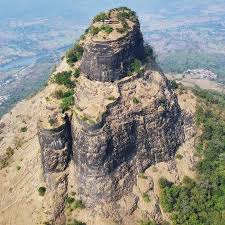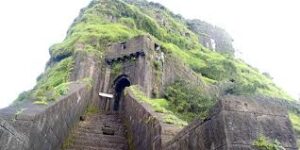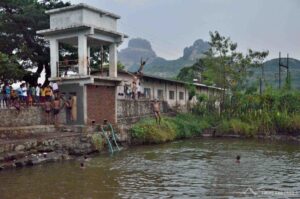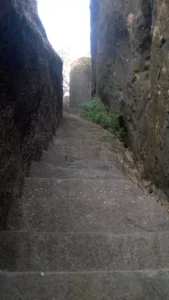
Table of Contents
Sarasgad Fort

Sarasgad Fort, a majestic hill fort near Pali in Maharashtra, is a paradise for trekkers and history enthusiasts. Standing at an elevation of around 1,600 feet, this fort offers breathtaking views of the Sahyadri ranges and the Amba River. Built during the reign of Chhatrapati Shivaji Maharaj, Sarasgad served as a watchtower and strategic fortification.
The trek to Sarasgad Fort is moderately challenging, featuring rocky terrains, steep climbs, and well-defined trails. As you ascend, you’ll encounter ancient water cisterns, caves, and sturdy bastions. The fort’s summit rewards trekkers with mesmerizing panoramic views and a sense of achievement.
Located near the famous Ballaleshwar Ganpati Temple in Pali, Sarasgad Fort makes for a perfect weekend getaway. Monsoon and winter are the best seasons to visit, offering lush greenery and pleasant weather. Whether you seek adventure, history, or natural beauty, Sarasgad Fort promises an unforgettable experience for every explorer.
Historical Significance of Sarasgad Fort
Sarasgad Fort has a rich historical background, deeply connected with the Maratha Empire. It was one of the forts captured and fortified by Chhatrapati Shivaji Maharaj. The fort was primarily used to keep an eye on the trade routes and enemy movements. Due to its proximity to Pali, where the famous Ballaleshwar Ganpati Temple is located, Sarasgad Fort also holds religious importance for devotees visiting the Ashtavinayak shrine.
Early History
Sarasgad Fort is believed to have existed since ancient times, with its strategic location making it a significant stronghold for various ruling dynasties. The region around Sarasgad Fort was historically under the control of different rulers, including the Bahamanis and the Adilshahi Sultanate, before coming under Maratha rule.
The fort’s history can be traced back to the Yadava Dynasty (12th-14th century) when several forts were constructed in the Sahyadri ranges to secure important trade and military routes. Sarasgad’s elevated position made it a crucial fort for monitoring enemy movements and providing refuge during conflicts. Over time, the fort witnessed numerous battles and power struggles as different dynasties sought to control this strategic stronghold.
During the Bahmani Sultanate (14th-15th century), Sarasgad Fort became part of their expanding empire. The Bahmani rulers, recognizing its importance, reinforced its defenses and used it as an administrative post to oversee their territories in the western region.
With the decline of the Bahmani Sultanate, the fort fell into the hands of the Adilshahi rulers of Bijapur (15th-17th century). The Adil Shah dynasty, which controlled large parts of Maharashtra, strengthened Sarasgad and used it as a base to monitor trade routes passing through the Konkan and Deccan regions. However, by the mid-17th century, as Chhatrapati Shivaji Maharaj launched his campaign to reclaim and fortify strategic forts, Sarasgad Fort came under the control of the Marathas.
Shivaji Maharaj’s Era
During the mid-17th century, Chhatrapati Shivaji Maharaj captured Sarasgad Fort and transformed it into an important military outpost. It served as a watchtower to oversee trade routes and protect the nearby Ballaleshwar Ganpati Temple, which was an essential religious center. Shivaji Maharaj focused on strengthening the fortifications of Sarasgad, ensuring that it could serve as a defensive structure in case of enemy attacks.
The fort played a role in the Maratha military campaigns against the Mughal and Adilshahi forces. Due to its elevated position, it provided an excellent vantage point for monitoring enemy movements and securing trade routes essential for the Maratha kingdom’s economy.

Post-Shivaji Era
After the death of Chhatrapati Shivaji Maharaj in 1680, the fort saw multiple power struggles between the Marathas, Mughals, and the British. The Mughals attempted to seize control of Sarasgad Fort along with other strategic forts in Maharashtra, but the Marathas successfully reclaimed and retained it as part of their stronghold.
During the Peshwa rule, the fort continued to serve as a key military post. However, with the advent of British rule in India, the importance of many hill forts declined, leading to Sarasgad Fort being abandoned as a military establishment.
Modern-Day Significance
Today, Sarasgad Fort stands as a testament to Maharashtra’s rich heritage and the Maratha Empire’s military prowess. The ruins of the fort, including its bastions, water tanks, and gateways, offer a glimpse into the past, attracting history enthusiasts and trekkers alike. The fort is now maintained as a trekking destination and a historical landmark, reminding visitors of the glorious past of the Marathas and their fortification skills.
Trekking to Sarasgad Fort
Sarasgad Fort offers an exhilarating trekking experience with moderate difficulty. The trek is around 4 km long and takes approximately 2 to 3 hours to reach the summit, depending on your pace. Here’s a breakdown of the trekking route:
Starting Point: Pali Village
- The trek begins from Pali village, known for the Ballaleshwar Ganpati Temple, one of the revered Ashtavinayak temples.
- Trekkers can find small shops in the village for refreshments and snacks before starting the journey.
Initial Ascent: Rocky Trail & Lush Greenery
- The initial part of the trek consists of gradual ascents through dense vegetation and rocky patches.
- During monsoons, the trail is surrounded by lush greenery and small waterfalls, making it a picturesque climb.
Midway: Caves & Water Tanks
- As you climb higher, you will come across ancient water cisterns, which provided drinking water to the fort’s inhabitants.
- Some small caves can be found along the way, offering shelter to trekkers in case of rain.
Final Ascent: Steep Steps & Bastions
- The last stretch of the trek is a bit challenging, with steep stone-cut steps leading to the fort entrance.
- The massive bastions and stone walls showcase the impressive fortifications of the Maratha era.
Attractions at Sarasgad Fort
Once at the summit, you can explore several fascinating structures that provide insights into the fort’s historical significance:
- Main Entrance (Mahadarwaja): The fort’s entrance is an imposing stone structure that has withstood the test of time.
- Water Reservoirs: There are several water tanks on the fort, some of which still contain potable water.
- Ruins of Structures: While much of the fort is in ruins, remnants of old houses, granaries, and military posts can still be seen.
- Panoramic Views: The fort offers a stunning 360-degree view of the surrounding Sahyadri hills, Amba River, and the lush green valleys below.
Best Time to Visit Sarasgad Fort
The ideal time to visit Sarasgad Fort depends on the type of experience you seek. Different seasons offer varying landscapes and trekking conditions.

Monsoon (June to September):
- The best season for scenic beauty, with mist-covered hills, waterfalls, and lush greenery transforming the landscape into a breathtaking paradise.
- The fresh, cool climate makes trekking enjoyable, but the trails can become slippery and challenging due to heavy rainfall.
- Streams and waterfalls emerge along the trekking route, enhancing the natural beauty but also requiring careful navigation over wet, rocky surfaces.
- Ideal for nature lovers and adventure seekers who enjoy trekking in misty, dramatic weather.
- Caution: Due to heavy rainfall, visibility may be reduced, and certain sections of the trail can become hazardous. It is advisable to wear proper trekking shoes with a firm grip and carry waterproof gear.
Winter (October to February):
- Considered the most comfortable season for trekking, with pleasant weather, clear skies, and cool breezes.
- The visibility is excellent, offering unobstructed panoramic views of the Sahyadri ranges and the nearby Ballaleshwar Ganpati Temple.
- The fort is surrounded by dry grass and crisp air, making it an ideal time for photography and exploration.
- Best suited for beginners and families looking for a relaxed yet adventurous trekking experience.
- Caution: Early mornings and late evenings can be quite cold, so it is recommended to carry warm clothing.
Summer (March to May):
- The fort experiences hot and dry weather, with temperatures ranging from 30°C to 38°C.
- The summer heat makes trekking exhausting and challenging, especially in the afternoons.
- The landscape appears dry and rugged, with fewer water sources available along the route.
- Recommended for seasoned trekkers who are comfortable hiking in warm conditions.
- Caution: To avoid extreme heat, start the trek early in the morning (before sunrise) or late in the afternoon and carry plenty of water, sunscreen, and a hat to prevent dehydration and sunburn.
How to Reach Sarasgad Fort
Sarasgad Fort is located near Pali village in Raigad district, Maharashtra. It is well-connected by road and rail, making it accessible for travelers from Mumbai, Pune, and other nearby cities.
By Road
Pali village, the base for the Sarasgad trek, is well-connected by road. Private vehicles, taxis, and Maharashtra State Transport (ST) buses are available from major cities.
- From Mumbai:
- Distance: 110 km (Approx. 3 hours by road)
- Route: Mumbai → Panvel → Khopoli → Pali
- Travelers can take the Mumbai–Goa Highway (NH66) or the Mumbai-Pune Expressway and exit at Khopoli towards Pali.
- State transport buses are available from Mumbai to Pali at regular intervals.
- From Pune:
- Distance: 90 km (Approx. 2.5 hours by road)
- Route: Pune → Lonavala → Khopoli → Pali
- The drive from Pune via the Mumbai-Pune Expressway is scenic, with beautiful landscapes along the way.
- MSRTC buses frequently operate between Pune and Pali.
- From Lonavala:
- Distance: 40 km (Approx. 1.5 hours by road)
- Route: Lonavala → Khopoli → Pali
- From Panvel:
- Distance: 65 km (Approx. 2 hours by road)
- Route: Panvel → Pen → Pali
- Private taxis and state transport buses are available from Panvel to Pali.

By Train
The nearest railway stations to Pali are:
- Karjat Railway Station (47 km from Pali)
- Well-connected to Mumbai, Pune, and other major cities.
- From Karjat, travelers can hire a taxi or take a bus to Pali.
- Khopoli Railway Station (35 km from Pali)
- Closest railhead with local train connectivity from Mumbai.
- From Khopoli, buses and private taxis are available to reach Pali.
- Panvel Railway Station (65 km from Pali)
- Serves as a major junction on the Konkan Railway route.
- Buses and taxis frequently ply from Panvel to Pali.
By Air
The nearest airport to Sarasgad Fort is:
- Chhatrapati Shivaji Maharaj International Airport, Mumbai (110 km)
- Well-connected with domestic and international flights.
- Travelers can hire taxis or take buses from Mumbai to Pali.
- Pune International Airport (110 km)
- Serves both domestic and international travelers.
- From Pune, buses and taxis are available to reach Pali.
Essential Travel Tips
- Wear comfortable trekking shoes with a good grip to navigate rocky and steep sections.
- Carry at least 2 liters of water, as the trek can be tiring and there are limited water sources on the way.
- Pack some snacks or energy bars to stay energized during the trek.
- During monsoons, carry a raincoat or waterproof gear to protect yourself from sudden rainfall.
- Wear lightweight, breathable clothing to ensure comfort while trekking. Avoid heavy fabrics that may cause discomfort.
- Use trekking poles if necessary, especially for those who may need additional balance and support.
- Carry a flashlight or headlamp if you plan to start early in the morning or return late in the evening.
- Apply sunscreen and wear sunglasses to protect against sun exposure, especially in the summer months.
- Keep a basic first-aid kit with band-aids, antiseptic cream, painkillers, and necessary medications for emergencies.
- Respect the historical site by not littering or defacing structures; keep the fort clean for future visitors.
- Be cautious of slippery surfaces during monsoon, as the stone steps and trails can become treacherous.
- Check the weather forecast before planning your trip to avoid unexpected rain or extreme heat.
- Travel in a group if possible; it ensures safety and provides support during difficult sections of the trek.
- Inform someone about your trek itinerary, especially if you are trekking solo, so they are aware of your whereabouts in case of emergencies.
- Capture memories but be responsible—avoid disturbing the wildlife or damaging any part of the fort.
Conclusion
Sarasgad Fort is a perfect mix of adventure, history, and natural beauty. Whether you’re an experienced trekker or a beginner looking for a rewarding climb, Sarasgad offers a fulfilling experience. Its historical significance, thrilling trails, and scenic views make it an unmissable destination for every explorer. The fort’s challenging ascent, coupled with breathtaking landscapes and a glimpse into Maratha history, makes it an ideal getaway for trekking enthusiasts and history buffs alike.
Furthermore, Sarasgad Fort is an excellent choice for those looking to escape city life and immerse themselves in nature. The fort’s proximity to the revered Ballaleshwar Ganpati Temple makes it an appealing destination for both devotees and adventurers. Each season brings a different charm to the trek—whether it’s the monsoon mist and cascading waterfalls, the winter’s crisp air, or the summer’s golden sunrise over the hills.
For photographers, Sarasgad offers incredible shots of rolling hills, rugged stone pathways, and ancient architecture. For those who love to explore historical forts, Sarasgad stands as a testament to Maharashtra’s rich heritage and the brilliance of Maratha fortifications.
No matter your reason for visiting, Sarasgad Fort guarantees a memorable and enriching experience. Pack your bags, lace up your trekking shoes, and set off on an adventure to conquer this majestic fortress. It’s a journey that promises not just a trek but a deeper connection with history, nature, and the thrill of exploration.

Sarasgad Fort Map
Follow More Fort
